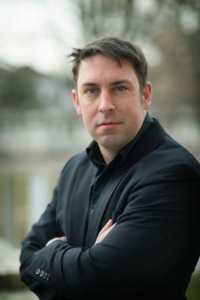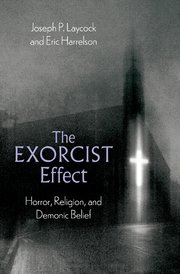Welcome to 7 Questions, our series where we highlight exciting scholars in the field of religion and get to know the person behind the book. For this article, we interviewed Joseph Laycock, whose co-authored book, The Exorcist Effect: Horror, Religion, and Demonic Belief, was recently published with Oxford University Press.
Get to Know Joseph

Joseph P. Laycock is an associate professor of religious studies at Texas State University. He is the author of several books including Speak of the Devil: How the Satanic Temple is Changing the Way We Talk About Religion (Oxford University Press, 2020) and The Penguin Book of Exorcisms (Penguin, 2020).
Joseph Answers Our 7 Questions
Question 1: What sparked the idea to write this book?
I had been thinking about writing a book like this since I first wrote on The Exorcist for a graduate course on American religious history. That was in 2008. “The Exorcist Effect” refers to a cycle where religious cultures inform horror movies, and movies, in turn, inform religious cultures. Currently we seem to be going through a cultural period of obsession with exorcism. The Conversation, an online magazine, asked me to write a piece on the history of exorcism. That resulted in multiple publishers reaching out to see if I could write some sort of book on exorcism. I started talking to an acquisition agent about this book and he was initially interested. I tapped Eric Harrelson as my co-author because he’s a film buff who used to work for the Alamo Drafthouse and organize film festivals in Austin.
But when Eric and I sent a full proposal to the agent, he told us it would never work: It was absurd to claim that horror movies affected religious belief. If you read the second chapter of our book, I think we have pretty strong evidence that they can. Cynthia Read from Oxford asked me what I was working on and when I explained how my proposal was rejected, she asked if Oxford could look at it. They gave us a contract and it became my third book with that press.
Question 2: What role does the sacred play in relation to your work broadly? Where do you see the sacred or sacred things in this book specifically?
In some of my other work, I’ve deployed functionalist definitions of religion. But in this case, we are using E.B. Tylor’s definition of the belief in “Spiritual Beings.” We’re looking specifically at horror movies dealing with demons, hauntings, and the supernatural. We also look at movies about “cults,” but horror movie cults are motivated by beliefs about “Spiritual Beings.” Three chapters of the book are dedicated to tracing how horror movies have shaped beliefs about exorcism, Satanic cults, and “evil rock music.” All of these things are “religious” in the substantive sense used by Tylor.
Question 3: Can you summarize the three key points you’d like the reader to walk away with when finished?
First, there really is overwhelming evidence that horror movies such as The Exorcist have had an enormous impact on the actual practice of exorcism as performed by The Catholic Church and other denominations. Our book opens by describing Cardinal John O’Connor in 1990 reading from The Exorcist in St. Patrick’s Cathedral. I think one reason why there is so much resistance to this idea is that the “lived religion” paradigm is still not taken seriously. Horror is still considered “low” culture, while Cardinals are regarded as serious intellectual elites. Cardinals aren’t supposed to be influenced by low culture, so when they are we don’t talk about it.
Second, the cycle we call “The Exorcist Effect” is still ongoing. The Exorcist was inspired by actual events and it fomented a surge of demand for demon expulsion. In the 1970s, that demand gave rise to figures like Ed and Lorraine Warren and Malachi Martin (both of which are the subject of chapters in this book). Their adventures inspired more movies. Father Gabrielle Amorth said The Exorcist was his favorite film. He founded The International Association of Exorcists, which has spent decades lobbying The Curia to revive exorcism. Now Amorth has been played by Russell Crowe!
Third, “The Exorcist Effect” can be quite dangerous, as demonstrated by the Satanic Panic of the 1980s and 1990s and the contemporary phenomenon of QAnon. Both these movements draw heavily on horror movie tropes. Horror depictions of cults also function as “plausibility structures” that make otherwise absurd conspiracy theories seem possible. However, we are adamantly not proposing censorship as a solution. Instead, what we need is information literacy so that the public is more thoughtful about where their ideas come from.
Question 4: Who were models or inspirations for you as you wrote this book?
The most obvious influence is Michael Cuneo, whose book American Exorcism talked about this phenomenon and pointed specifically at the Warrens and Malachi Martin. In many ways, we are building and expanding on that book.
We are also influenced by religion and film scholars S. Brent Plate, Doug Cowan, Steve Wiggins, and a few others. Lastly, we drew a lot on neuroscientist Jeffrey M. Zacks and his book Flicker, about how movies affect the mind.
Question 5: What was the most difficult thing about writing the book? Did you encounter any unexpected problems or challenges?
As a New Religious Movements scholar, I am used to writing about a bunch of living people, many of whom feel I am telling their story all wrong. So compared to dealing with that, it was relatively easy using only archival sources and select interviews.
We really wanted to present new data on figures like The Warrens and the way to do that was archival research. We found out that The Warrens had a regular tabloid column for a while. But nobody archives tabloids. We actually found some of their columns at The Sixth Floor Museum at Dealey Plaza in Dallas. The Museum archives anything related to the Kennedy assassination, including tabloid conspiracy theories. Their curator scanned some of the Warrens’s old columns for us, and said it was one of strangest requests they’d ever had.
Finding reliable information about Malachi Martin was very difficult, due to the volume of wild stories swirling around this figure. We found some documents from the Guggenheim foundation, which funded Martin for a time. We also communicated with the author of Disguised as a Man: Malachi Martin and Me, written by a woman who experienced a toxic relationship with Martin. I felt Disguised as a Man was a well written and deeply disturbing book.

Question 6: What has surprised you the most about the book, either in its writing or reception?
One thing people tell us is that they are surprised by the level of detail in our research. Horror is sometimes described as “ghettoized genre” and media stories on the history of horror are often superficial. I think some people are used to clickbait lists like, “10 scary movies based on true events!” We really dug deep and tried to find everything that we could on these films, their influences, and how they shaped the culture. We went through hundreds of articles and interviews. We interviewed film makers, authors, paranormal investigators, and others. We even attended a “ParaCon” event so we could see the Annabelle doll in person. I hope our thoroughness comes across in The Exorcist Effect.
Question 7: With this book done, what’s up next for you?
We found so much on The Warrens that it was too much for just a chapter. The Warrens left a serious mark on America’s religious landscape and it is surprising there is virtually no real scholarship on them. Eric is interested in doing a follow up project on these two.
I am currently interested in the conspiracy theory that the world is secretly run by reptilian humanoids. It seems like a very silly idea, but a shocking number of people who believe this idea have killed people or committed suicide as a result. This is another example of a topic that has not been taken as seriously as it should be because it seems risible.
You can order The Exorcist Effect: Horror, Religion, and Demonic Belief here.
